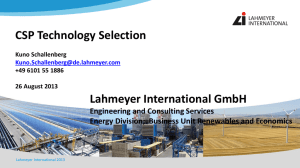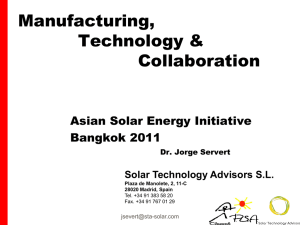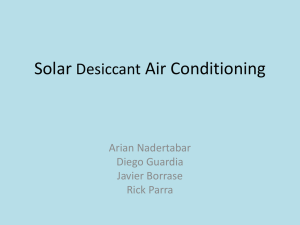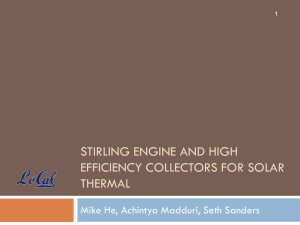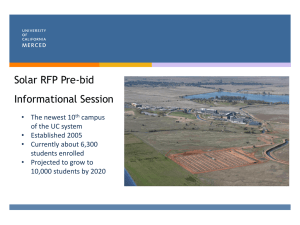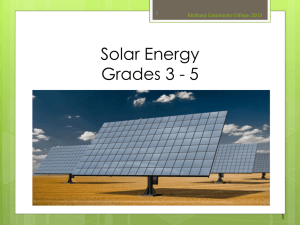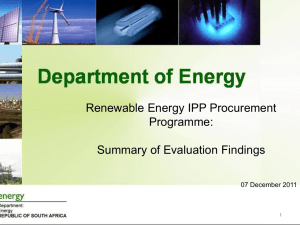SOLAR PV PUMPS FOR AGRICULTURE AND RELATED USES
advertisement
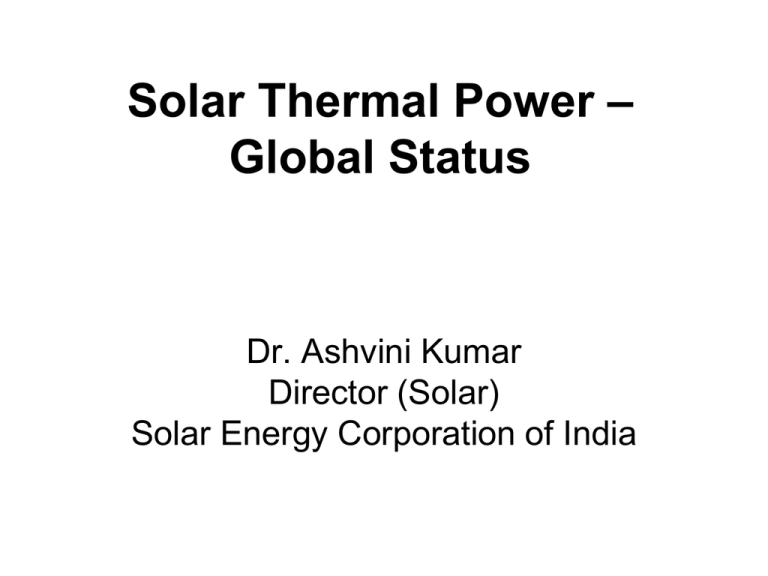
Solar Thermal Power – Global Status Dr. Ashvini Kumar Director (Solar) Solar Energy Corporation of India Solar Thermal Energy • Solar radiation is captured as thermal energy and transferred as heat to perform various useful applications • Depending upon operating range of temperatures, applications are classified as High temperature applications, usually greater than 300 deg C Medium temperature applications, greater than 80 deg C and up to 300 deg C Low temperature applications, less than 80 deg C • In India, good progress has been made in the development and promotion of solar thermal power in last couple of years. Solar Thermal Power Generation • Also referred to as CSP (concentrating solar power) technologies for power generation • Technology Options include – Parabolic Troughs – Linear Fresnel Reflector systems – Central Receivers or Power towers – Paraboloid dish systems • Thermal storage and hybridization with conventional sources are the biggest strength • Lot of scope for indigenization, local manufacturing and employment generation. Parabolic Trough Technology Parabolic troughs focus the sun onto a linear receiver. The parabolic troughs track the sun and concentrate sunlight on to the receiver tubes placed in the trough focal line. Solar energy is harvested to give temperatures up to 400 deg C. Hot liquid is passed through a series of heat exchangers to generate steam, and to drive a turbine Rankine cycle configuration is used for power generation 354MWe “SEGS” plants going strong after 20 years Steam turbines are the dominant power house Linear Fresnel Reflector (LFR) Similar to parabolic trough technology Parabolic trough is sliced into individually tracking strips of mirrors and installed near the ground Receiver is stationary and does not move with the mirrors as in the trough systems, and thus provides additional design flexibility. Has the advantage of lower production costs and require least amount of land per MW capacity among all solar technologies Linear Fresnel Reflector Technology 1.5 MW Capacity plant at Murcia, Spain (Air cooling system is used) Central Receiver Systems Uses a field of mirrors called heliostats that individually track the sun on two axes and redirect sunlight to a receiver at the top of a tower. Sunlight is concentrated 600–1,000 times, and achieves working fluid temperatures of 500°–800°C. Can use various HTFs including steam, air, and molten nitrate salts (60% sodium nitrate and 40% potassium nitrate) 5 MW e-solar Power Plant • 2 towers • 20 acres land • Two 65 ton natural recirculation thermal receivers • Steam temperature= 440 C • Steam pressure = 60 bar • 24,000 mirrors Paraboloid Dish Systems These systems use series of mirrors arranged in a concave plate to focus light onto a point Usually, a Stirling external combustion engine is placed at the focal point for collecting heat to drive pistons by continually expanding and condensing hydrogen gas With gas turbine, Brayton cycle may also be used. Global Status of Installations Operational CSP Capacity (Total = 2136 MW) Technology Pattern 1800 1532.4 1600 60 1.5 36.4 157 1400 Dish Stirling 1200 LFR 1000 ISCC 800 Parabolic Trough 600 400 1881.25 200 25 0 Tower 507.5 1 20 1.5 2.5 17.25 5 20 5 Under Construction CSP Capacity under Construction Total = 2648 MW Under Construction Technology Pattern (in MW) 1200 1010 1000 1 12 Capacity (MW) 508.9 776 800 dish LFR 600 470 Parabolic Trough Tower 400 250 2125 200 100 28.5 13.4 0 China France India Israel Spain UAE USA Global Efforts for development of Large scale CSP projects • Indi(a)genization • Must be scalable and replicable • Must reach early cost competitiveness with the conventional power generation and easy dispatchability. • Reduction in water usage as good DNI areas may not blessed with water availability • Building provision of thermal storage Thermal Storage • A storage system enables – To negate the variability in system output due to sudden shifts in the weather, and – extend the range of operation beyond daylight hours • The power produced throughout the day can be more effectively matched with energy demand, therefore increasing the value of the power as well as the total useful power output of a plant. International Developments • Base load CSP power plant – Gemasolar (Power tower, 19.9 MW, Spain) • CSP with storage – up to 7 or 8 hours is considered commercial (several in Spain) • Dry cooling CSP power plant – Puerto Errado I (Linear Fresnel, 1.5 MW, Spain) • High operating temperatures – Gemasolar (Power tower, 19.9 MW, Spain), Priolo Gargallo (Parabolic troughs; 5 MW, Italy) • Gas hybridization – all Spanish CSP plants (> 800 MW operational) • Coal augmentation – Hassi R’mel (Argelia), Al Kuraymat (Egypt), Ain Beni Mathar (Morocco) (parabolic troughs) • Stirling Engines – Maricopa (1.5 MW, USA), Spain (several locations), Portugal (Government CSP demonstration projects in several locations) Large scale CSP projects JNNSM: Phase-I 1,000 MW capacity Grid Solar Power Projects A provision of 500 MW capacity of Solar Thermal power was made. 2.5 MW capacity solar tower project installed, and 7 projects of aggregate capacity of 470 MW are under implementation having time for completion till May 2013. Some pilot projects are proposed, besides R&D efforts to develop the test and simulation infrastructure. 17 Pilot Projects • Aim is to address issues related to optimization, variability of solar resource and storage constraints and targetting space-intensity through the use of better technologies. • This means • Advanced technology configurations which could lead to cost reduction through higher efficiency and CUF, and scale effect. • Reduction in water consumption and footprint land area • Potential for replication in commercial projects soon after success of demonstration projects • Potential for indigenous manufacturing Project Configurations and Sites Based on recommendations of the stakeholders group and site visits by experts, identified pilot projects to have the following configurations: Project Configuration Identified sites and Broad Specifications With hybrid cooling Bhadla (Rajasthan) Available Land Area: 150 ha Reduced (<= 30%) consumption of water Capacity: 40 MW est. CUF: 29% est. High operating temperature Charanka (Gujarat) Available Land Area: 140 ha (>=500ºC) Higher efficiency Capacity: 35 MW est. CUF : 30% est. Terkuveerapandiyapuram (Tamil Nadu) Large thermal storage Available Land Area: 160 ha (about 8 hours) Capacity: 25 MW est. CUF : 45% est. Large thermal storage Nennala (Andhra Pradesh) Base load Available Land Area: 160 ha Capacity: 20 MW est. CUF : 65% est. National Solar Thermal Power Testing, Simulation and Research Facility • 1MWe Solar Thermal Power Plant • Research and Demonstration plant • Combination of different collector fields giving direct and indirect steam generation Parabolic Trough Field 8700 sq. m (3.3 MWth) Linear Fresnel Field 7200 sq. m (2.2 MWth) Turbine operating conditions: saturated steam at 350 deg. C and 40 bar 1 MW with 16 hour thermal storage Project at Mount Abu By WRST with co-funding from Indian and German Ministry Solar Tower Technology - 1 MW(th) Solar power plant based on tower technology by M/s Sunborne Energy, Gurgaon, jointly with Institutions from USA, Spain and Switzerland. Steam Turbine Hot Air Receiver Generator Steam Generator Thermal Storage Blower Blower Cold Air Heliostats Tower `
